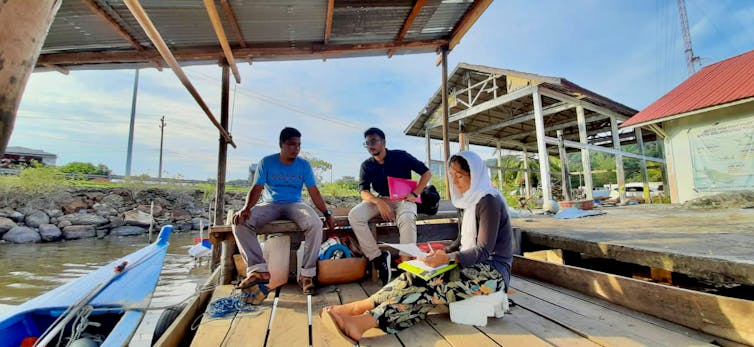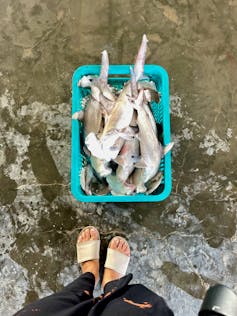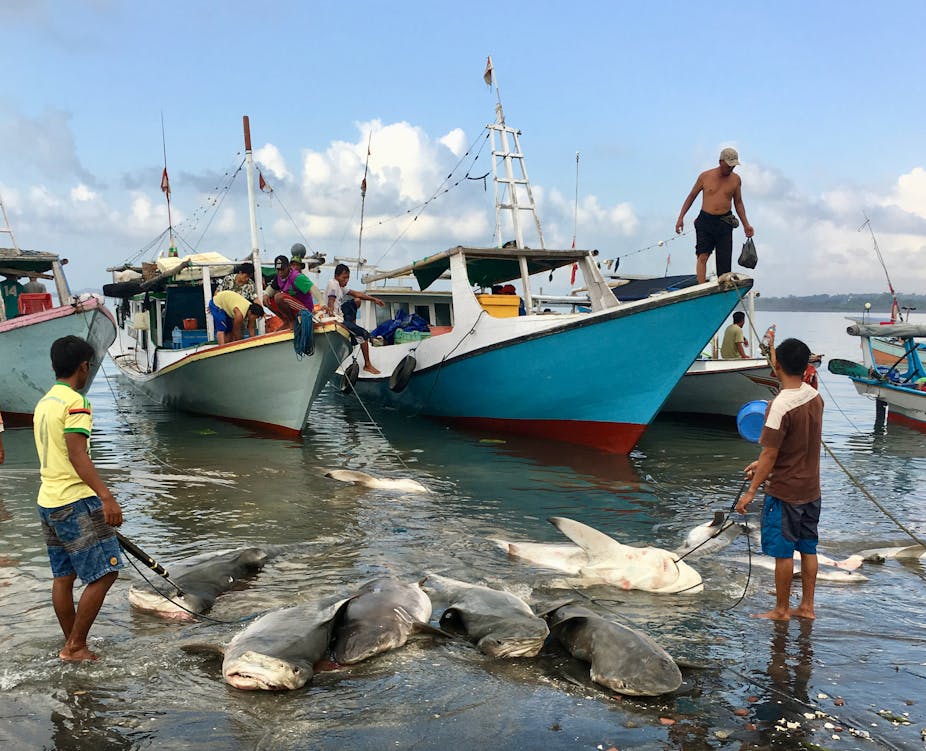Countries from around the world have voted to limit the global trade in sharks under the Convention on International Trade in Endangered Species (Cites). Trade in shark products is a major driver of shark overfishing, leading to the deaths of millions of sharks every year. The new Cites listings aim to keep the international trade of 54 species of shark and ray within sustainable limits.
But there are concerns that Cites listings could unintentionally drive up the price of shark fins and lead to the development of informal shark fin markets. Catches of many species already listed on Cites remain valuable for small-scale fishers. And in 2018, Cites-listed sharks remained among the leading species traded in contemporary fin markets.
Yet targeted fishing is just part of the issue. Sharks are frequently caught as unintentional bycatch by fishers using unselective nets and lines. And since Cites only pertains to international trade, many sharks that are traded and consumed in local or domestic markets are not covered by the regulations. Strict rules protecting sharks in these markets could negatively impact the livelihoods of the small-scale fisheries that depend on them for food and income.
Interventions to reduce catches of threatened shark species must support the rights and welfare of small-scale fishers and be perceived as legitimate. My colleagues and I conducted research on small-scale fisheries in Indonesia – the world’s largest shark fishing nation.
Fishery-led conservation
We focused on two taxa, hammerhead sharks and wedgefish. These taxa are both critically endangered and already listed on Cites.
Applying research methods from behavioural science and economics, we interviewed 144 fishers from two villages in the Indonesian shark fishing hotspots of Aceh and Lombok. We presented fishers with a range of conservation scenarios and asked them how their fishing behaviour would change under each.

The first scenario involved the introduction of a new rule stipulating that particular species could not be legally caught or brought to shore. The rule was accompanied with a fine for non-compliance.
The second was a voluntary programme to protect the species. Fishers could choose to reduce their catch or release accidentally caught sharks rather than have a rule imposed on them.
The third approach was based on compensation. Fishers would receive payments for reducing their catch of endangered sharks equivalent to the value they could otherwise have received for it.
For scenarios that involved monetary incentives, we asked fishers to indicate how much they would be willing to pay to continue fishing for endangered sharks or how much they would accept to reduce their catch. We then asked fishers to explain why they would (or why they would not) change their behaviour and how they planned to reduce their catch.
Support for financial compensation
The rule and fine scenario was unpopular among the interviewed fishers. Only 50% of those interviewed in Lombok and 20% in Aceh said they would reduce catches in response to the rule and fine scheme. They felt it was impractical, unfair and would negatively impact their welfare due to reducing their income and eliminating a key source of food.
Research suggests that if conservation rules are not accepted by local fishers, then they often fail to have a meaningful effect on fisher behaviour.

The voluntary programme was more popular. 55% of fishers in Aceh stated they would voluntarily stop catching wedgefish.
But the fishers expressed a strong preference for a programme based on compensation. 98% of all fishers interviewed said they would stop catching hammerheads while 96% said they would stop catching wedgefish if their lost income was compensated for. Fishers in Aceh were willing to accept less than US$2 (£1.63) per hammerhead shark and US$4-7 (£3.27–5.72) per wedgefish.
Based on data from our study, we estimate that it would cost just US$12,000 (£9,800) per year to save up to 20,000 hammerheads and wedgefish in Aceh.
Although not tested by our study, an approach based on compensation is likely to be more cost-effective than interventions that require enforcement. The exact cost of enforcing a rule and fine policy in Indonesia is unknown, but the annual cost of a single marine patrol boat in the USA is between US$40,000 and 100,000 (£32,600 and 81,000).
The fishers also felt that a compensation scheme was fair and would deliver positive social outcomes for their villages.
We are now trialling such a scheme at the two sites in Aceh and Lombok. Fishers receive financial compensation if they share a video of the safe release of hammerheads or wedgefish. More than 150 animals have been safely released since April and fishers have so far reported using the payments to support their families and send their children to school.
Broader implications
One size fits all shark conservation measures, based on the enforcement of rules, fail to account for the diversity of fishing contexts and their socio-economic challenges. Cites listings can play a part in supporting the recovery of threatened shark species by better regulating international trade. But nuanced management measures are also needed to reduce catches in the context of limiting harm to small-scale fishing communities.
Governments are expected to agree on a new global framework to protect and restore nature at the UN biodiversity summit COP15 this month. The long-term vision of this framework is “living in harmony with nature”.
Our research, in line with this vision, offers a scalable method for designing conservation interventions that are appropriate for different fishing contexts. More importantly, it supports the development of solutions that involve the people most affected by conservation.

